Disclosure: Please note that some links are affiliate links, and at no additional cost to you, we earn a commission if you make a purchase.
If you would like to support this website in some way, using these links will help do exactly that.
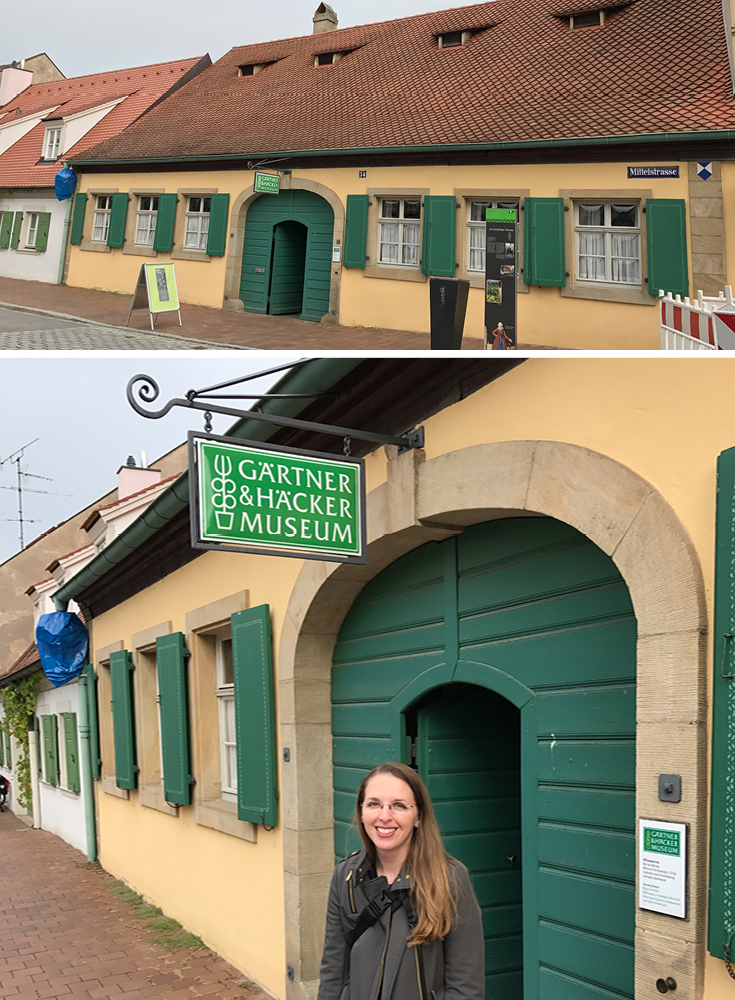
A large part of what makes Bamberg who it is as a city, and worthy of UNESCO world heritage as an entity, is it's unique gardening culture within the city limits. To understand why this is important, you have to see it. Visit Bamberg Market Gardeners’ and Vintners’ Museum and explore the surrounding gardening neighborhood with a guided map (sorry only in German Gardeners' District circular route (1,6 MB))
First off, I loved visiting the Gardeners’ and Vintners’ Museum in Bamberg. It was easily the most meaningful part of my trip to Bamberg. However, leading up to visiting, I was uncertain what I was really in for. The official website is completely in German, and the only other mention in English was abbreviated on other sites. If the website was only in German, would the museum only be in German? I was relieved to discover some English signage, and the available audio tour was completely available in English. So never fear! To help with the language barrier, I’ve typed up two of the English signs which I found at the museum that provide a great overview. Altogether, with my comments and photos, you'll agree that this museum is a must-see in Bamberg, Germany!
Listen to the Audio Guide, or Pass?
There are very, very few signs in the exhibits. You really need the audio guide to get the most out of your visit. The audio guide numbers hang from the ceiling and if it was a solid color and or had a wreath it was a main/general topic. Others were about specific items, like the kids toys. This way you still control your trip, rather than having the audio guide tell you where to go, which was nice.
How Long Will a Visit Take?
Estimate 1 hour if doing the audio guide.
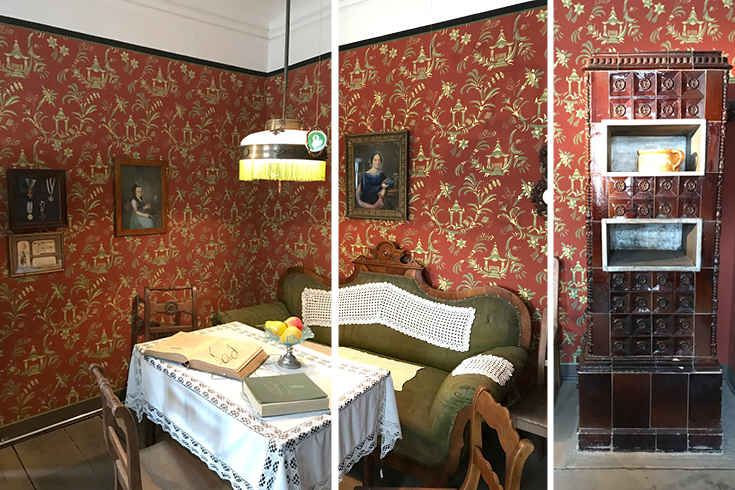
Taken from English Signage in the Museum
“Welcome to the Gardeners’ and Vintners’ Museum!
The museum offers an insight into the lives, culture and history of the city’s market gardeners and vintners. When Bamberg received World Heritage Site status in 1993, the unique cultural landscape of the market garden lands within the citiy was one of the reasons.
Based in a typical gardener’s house from 1767, this indoor and outdoor museum invites you to learn about the gardeners’ lives around 1900. The diversity of vegetable and herb varieties as well as tools and religious customs are also documented. The gardeners and vintners of Bamberg founded a museum society in 1975 and opened their museum in 1979. In 2012 the exhibition was completely redesigned.
Since the late Middle Ages, Bamberg’s gardeners have made use of the lands east of the Regnitz river. The mild climate was conducive to growing many varieties originating in Mediterranean areas. Bamberg’s gardeners became known throughout Europe and achieved commercial success through the trade in liquorice root (the raw material for medicinal remedies and liquorice confectionery) as well as in seeds for onions, caraway, leeks, swede, turnips and beets, kohlrabi, lettuce and spinach.
The vintners’ were known, like the gardeners, as farming townsmen (Häcker in local dialect, which derives from the hacking action associated with their work and their tools). In the 18th century the climate grew colder due to the Little Ice Age and production of Bamberg wine, which had come to be called belly-biter (Ranzenbeißer), was no longer viable. The producers switched to hops, fruit and grains.”
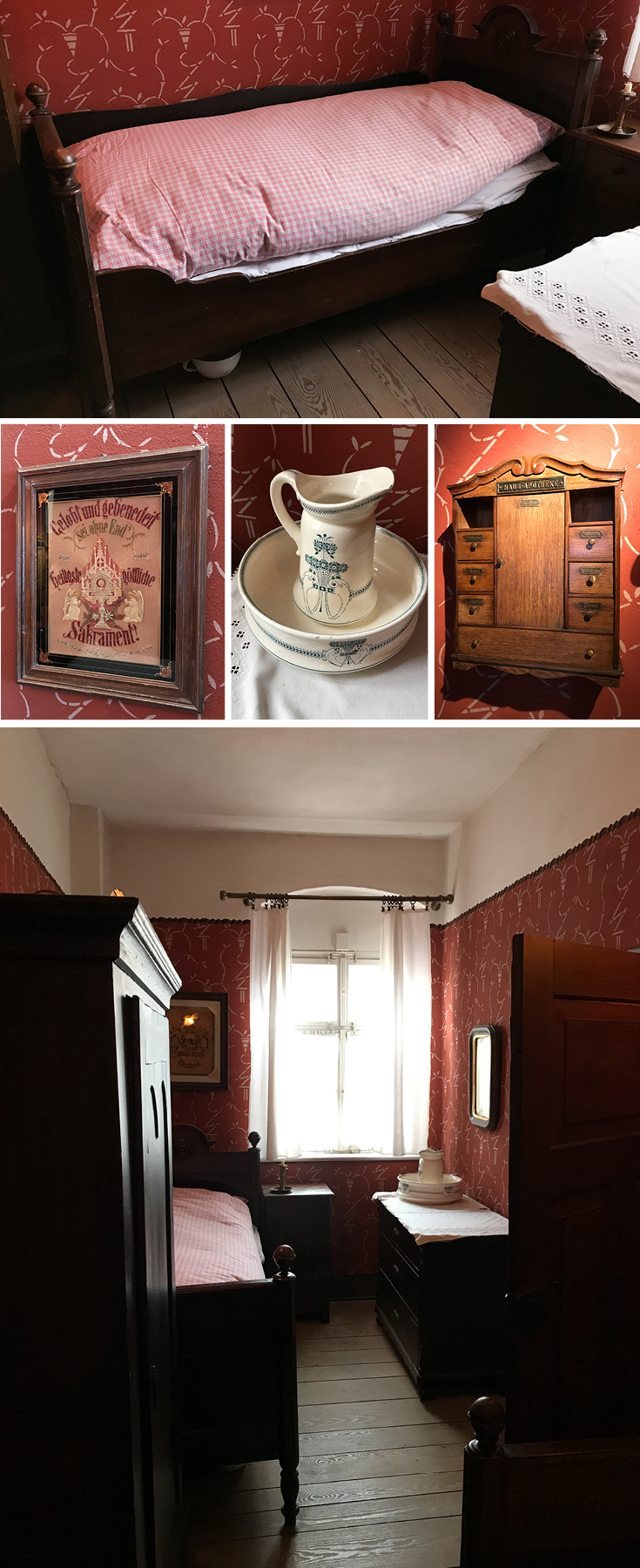
The Gardeners' Home
The home was styled for 1767 with a general parlor, kitchen, bedroom, kids’ room, grandparents’ room (which was an exhibit room and not styled as it was during the time). The through-way, or center foyer of the house was designed to allow a wagon to pass through to store food directly above the living quarters or to the garden out back.
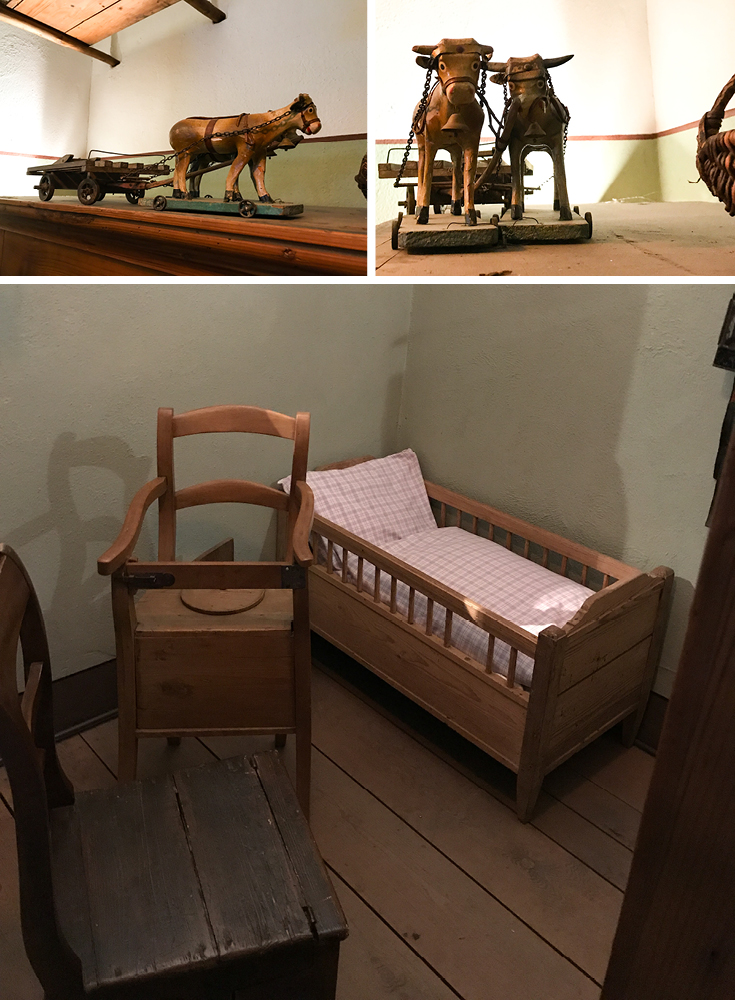
The Kitchen was Surprisingly My Favorite Room
I loved how they used open shelving to organize the kitchen. The stencil border, periwinkle blue, and stone tile combined for a charming kitchen. Attached directly to the wall are metal containers for flour and salt where you could directly scoop from while cooking.
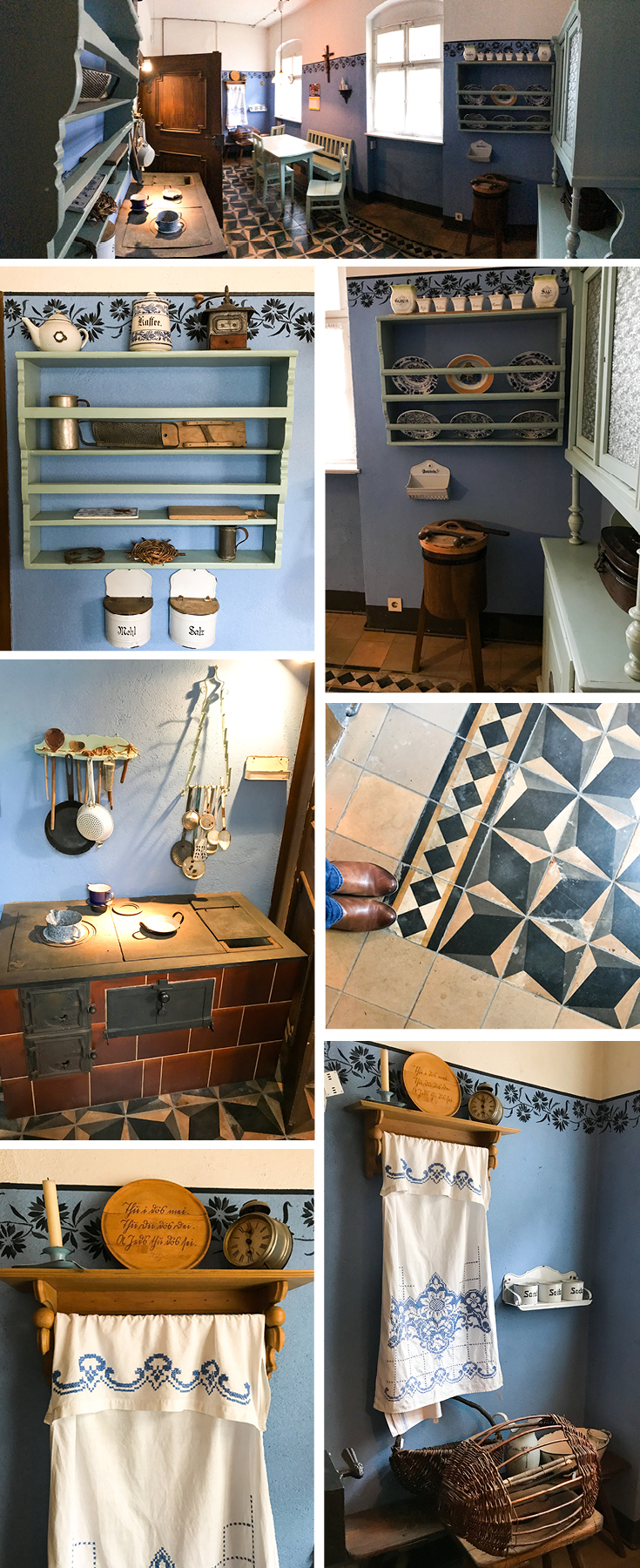
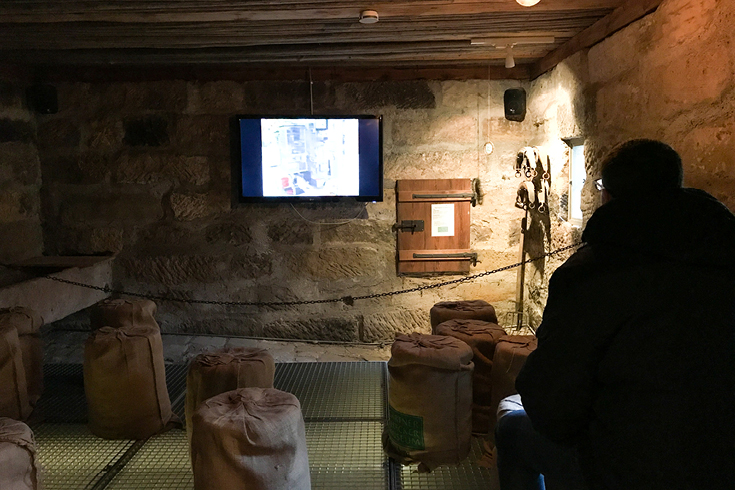
Hay Loft
In the loft above, there was an interactive video oriented display that explained the different farming and gardening tools. They also had period costumes of the time as well as a large historical photo showing the sellers, and the baskets they carried and sold from.
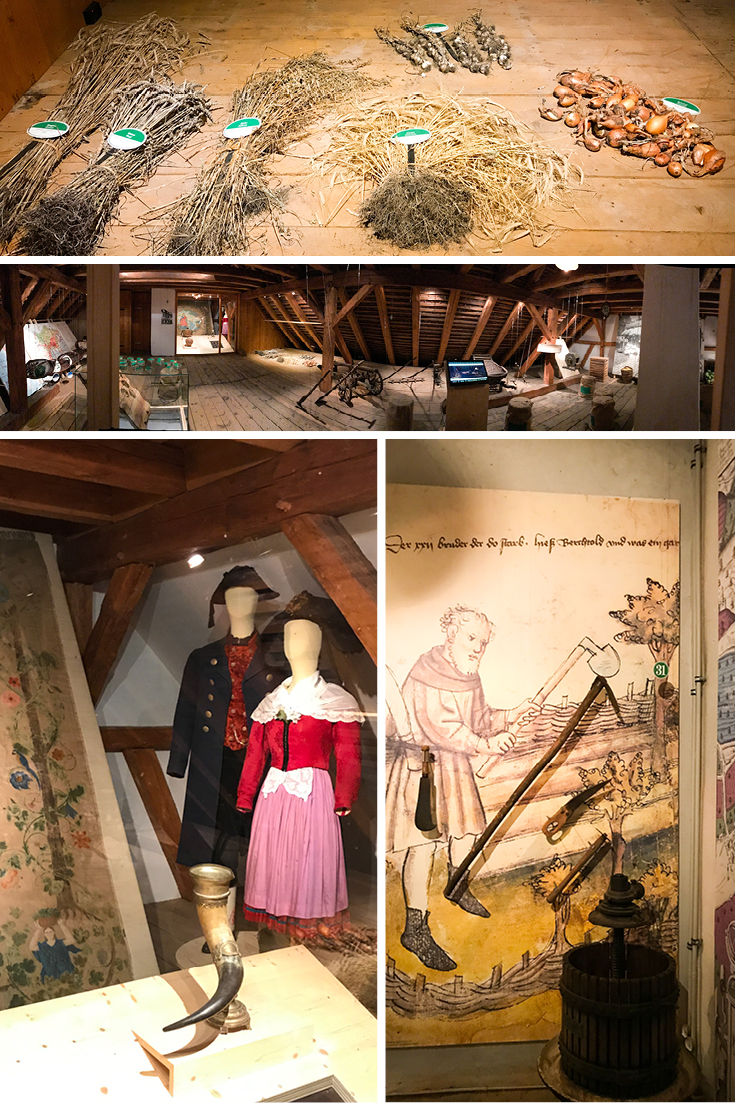
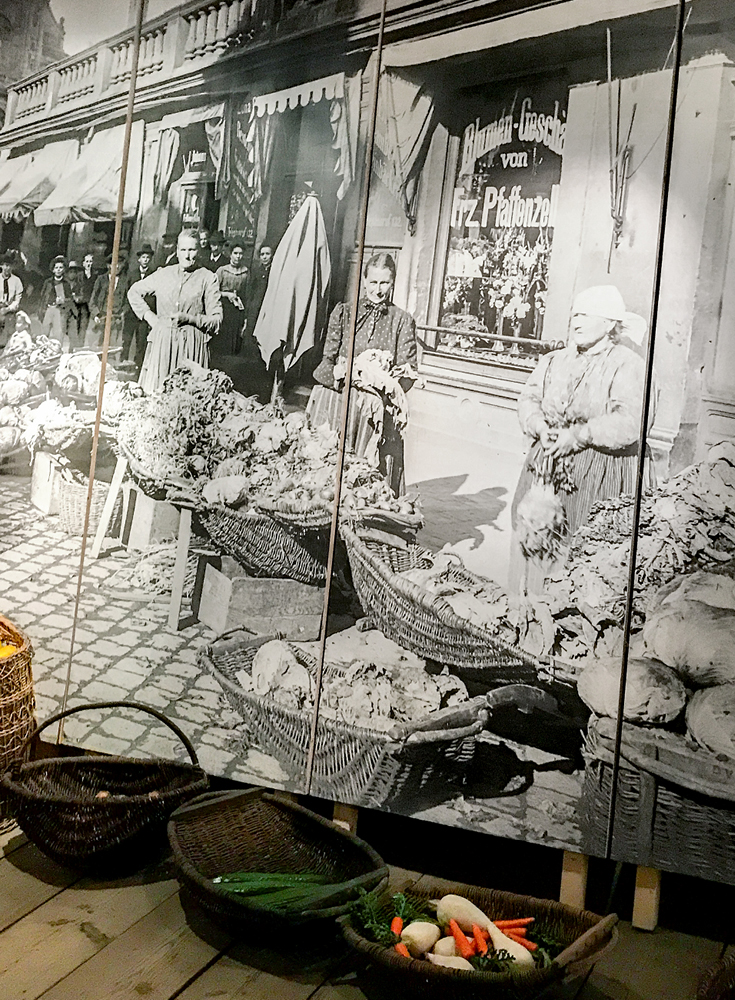
The Grandparents' Room
Here, the Museum showcases the Guild's processional staffs that were used in religious ceremonies and parades.
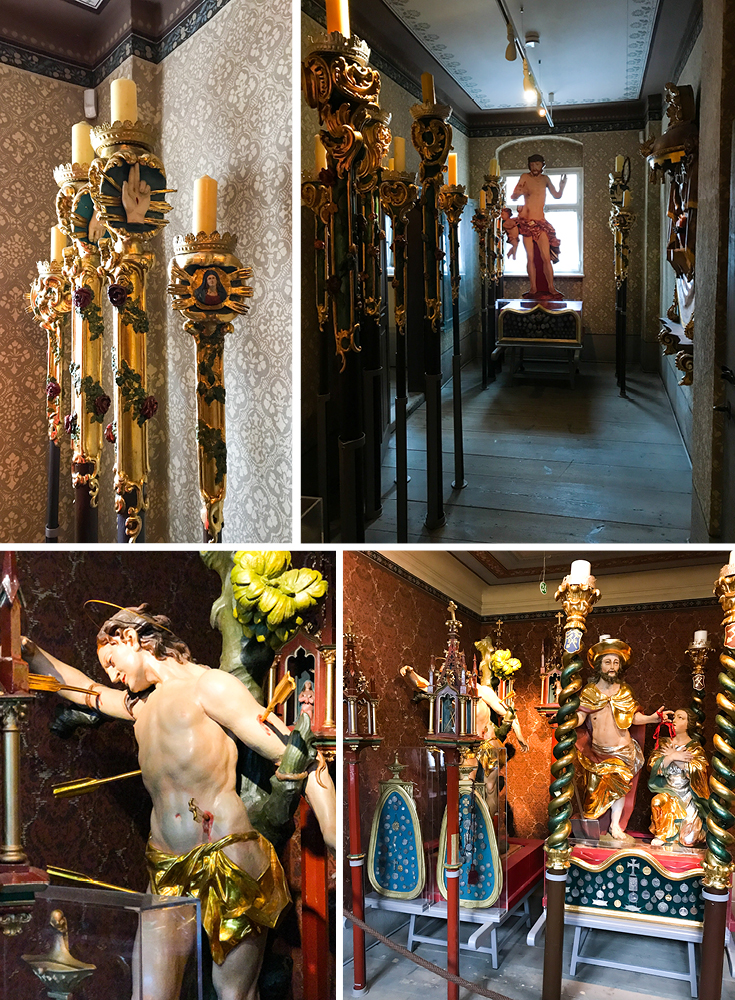

Bamberg Heritage Garden
The working garden out back had everything from flowers to vegetables. A church stood sentry in a distance making for a picturesque vista.
Taken from English Signage in the Garden:
“Bamberg Heritage Garden: Helping to conserve the “green heritage” of Bamberg’s gardeners
The Bamberg Heritage Garden was founded as part of the Urban Gardening Project run by the Bamberg World Heritage Office. In July 2013 a specially-founded voluntary association took over the running of the Bamberg Heritage Garden. The plants are cultivated following organic principles by volunteer workers from the association. The Bamberg Heritage Garden contributes to the conservation of the rare, local Bamberg vegetable varieties. It assists in the rediscovery of vegetables and varieties that are unique to Bamberg, some of which may already have died out or been forgotten. In the past, the seeds of local varieties, as well as knowledge about how to use them, have been lost. The Heritage Garden is intended to counteract such loss. In addition to preserving the ‘green heritage’ of the Bamberg gardeners, the garden is also a place where knowledge about growing and tending can be handed down-intangible heritage.
In the Heritage Garden multiple varieties of a plant are grown side by side, compared and explained. In this way, the Bamberg Heritage Garden helps maintain biodiversity, while also making history and environmental education come alive. Along with the well-known Bamberg local varieties of garlic, onion, radish, pointed savoy cabbage and the ‘Hörnla’ potato, numerous heirloom varieties of bush and climbing beans from the Bamberg region are being grown, which in former times were of great importance in local cuisine. In the course of the project seeds have also been discovered of lone local variety previously believed to have been lost- the Bamberg pear-shaped onion. This onion variety has been cultivated in the Heritage Garden since it's rediscovery, with the aim of propagating the seeds and preserving the variety for future generations.”
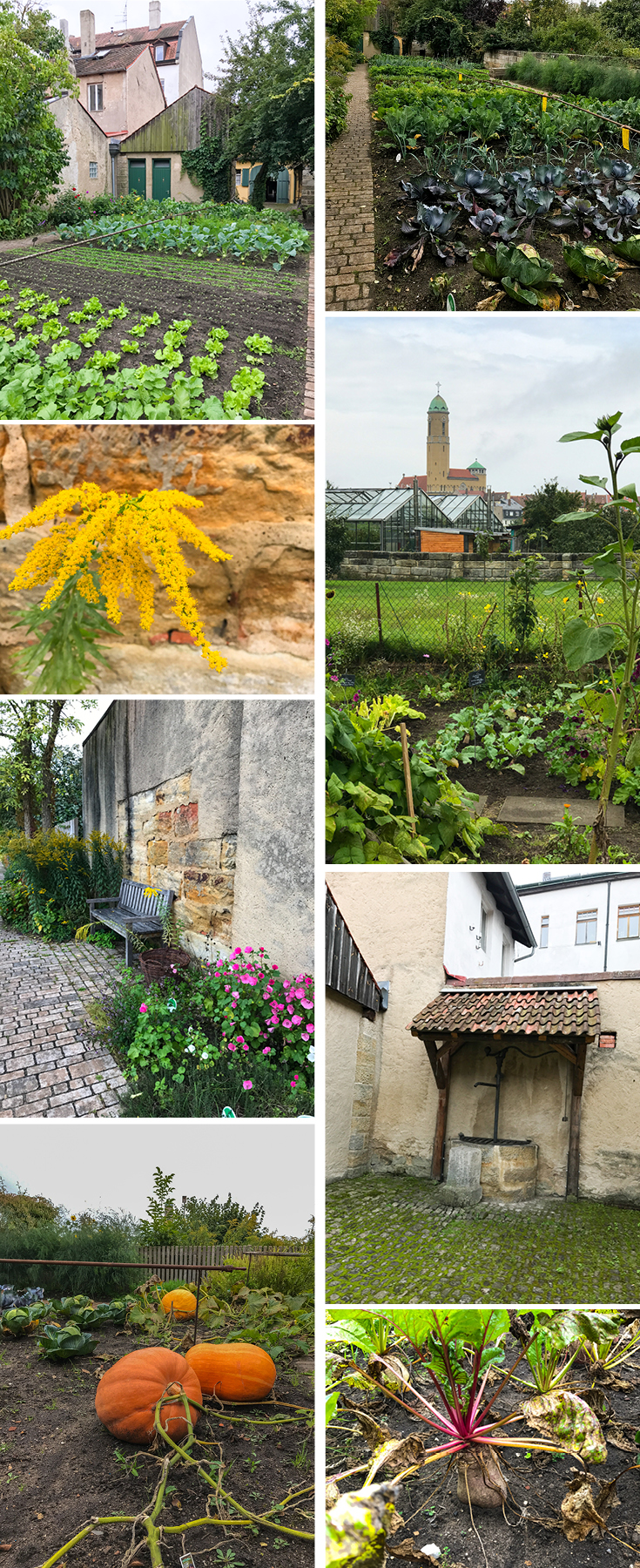
Follow Along
If you enjoyed this article, or these topics sound interesting to you, you'll love our weekly newsletter. You'll receive the newest posts each week and exclusive access to free planning resources like ‘Packing List & Tips for 2 Weeks in Germany’ and ‘Everything You Need to Rent a Car in Germany’.
Thank you for reading!

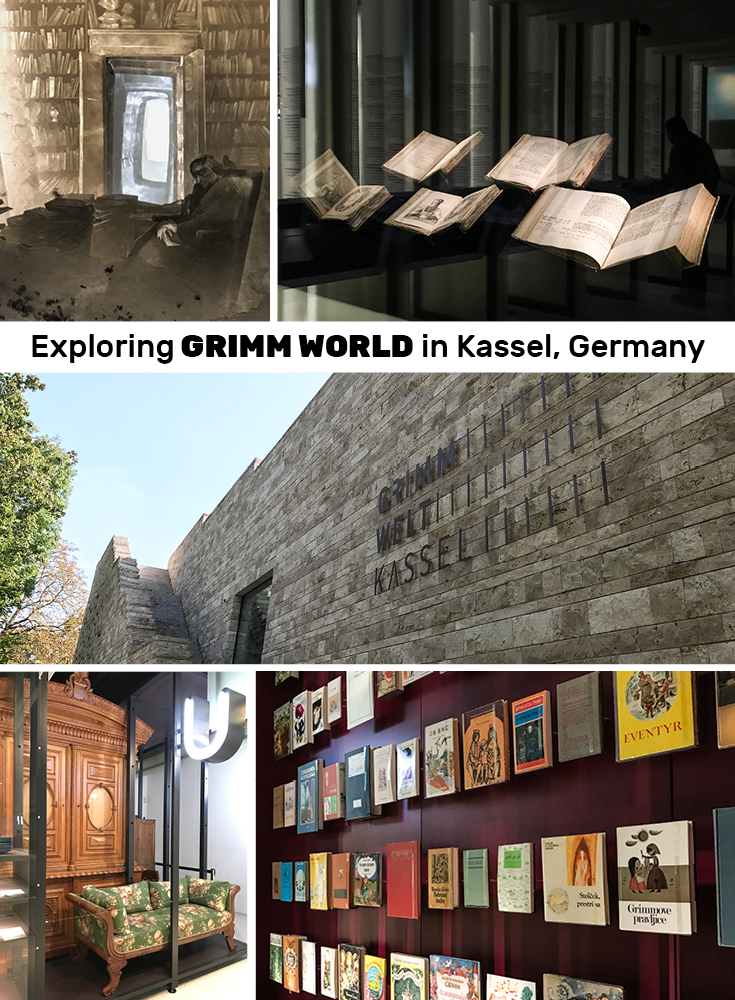
Have you ever visited a city, solely for the museums? I do all the time. On our last adventure into Germany, I was lured to the city of Kassel by the siren song of the modern, hip, intriguing promise of visiting GRIMMWELT, literally in English GRIMM WORLD, a museum that is dedicated to EVERYTHING Grimm brothers. This museum goes beyond the fairy tales to include their work on a German dictionary, and includes in their scope the work of other Grimm siblings. Opened in 2015, everything is clean, open, modern, spacious, minimalist, and innovative. It's equal parts biographic, linguistic heritage, and art museum. It's a museum that strives not to be your typical, stuffy museum, and is very successful in that endeavor!
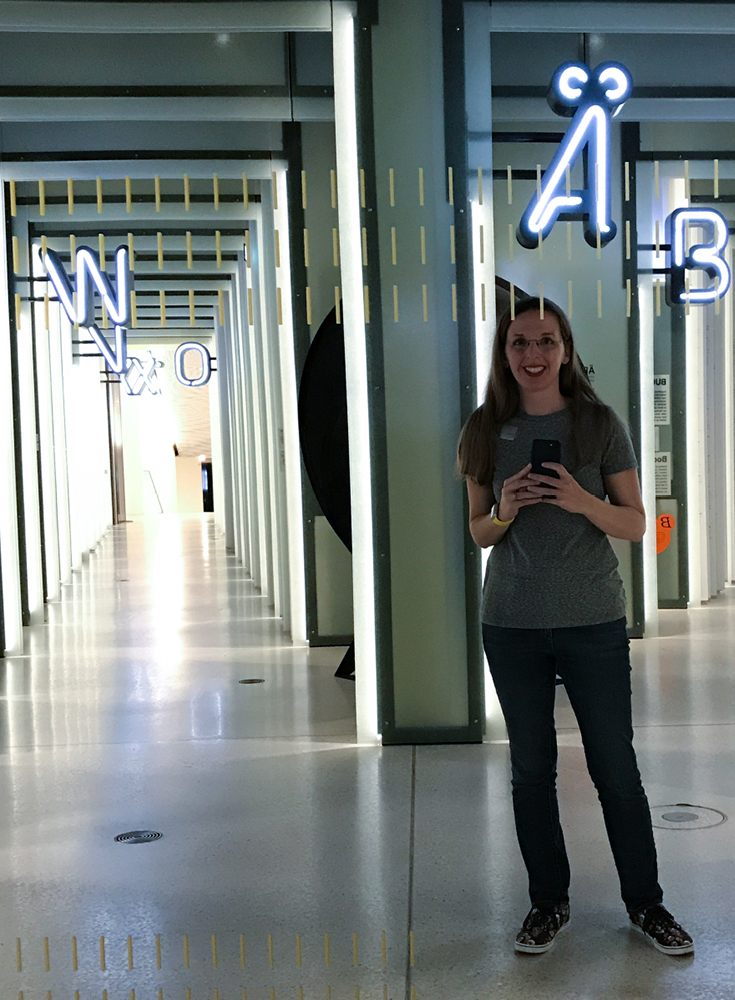
The organization of the museum is navigated by the alphabet, and a modern LED letter marks exhibits on both floors. However, you do not progress through the museum in alphabetical order. It irked me at first that the letters are out of order, but there’s a reason for this choice. Without being fluent in German, it's a little overwhelming to try and understand why a specific letter corresponds with an exhibit, but they provide a PDF guide in English to help.
Jacob and Wilhelm Grimm’s Lifelong Projects
The main floor of GRIMM WORLD is dedicated to Jacob and Wilhelm Grimm’s lifelong projects of creating a German dictionary, translating stories, and collecting German folk and fairy tales. I was astonished to see how many personal belongings they had in their collection. They had scissors, delicate paper cut outs, first editions of their fairy tale collection from 1812 and 1815 with their handwritten notes in the margins, and first editions of other language translations that the brothers completed. These precious books were in glass display cases with safe lighting, and the exhibit room itself was designed to feel like flipping through the pages of a book.
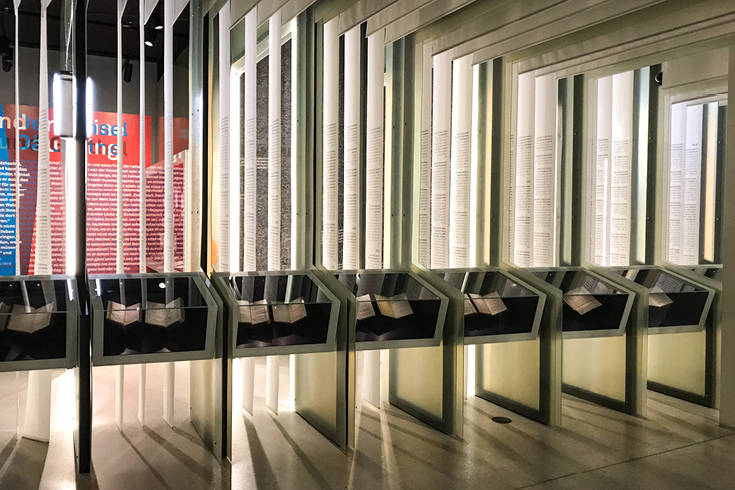
During their lifetime, the Grimm brothers completed words from A to the letter F for a German dictionary, and the dictionary itself was completed a hundred years after the brothers’ deaths. Why would you want to learn about the history of the German dictionary while visiting a city? GRIMM WORLD makes learning about it interesting and worthwhile through jaw-dropping artwork. I soon realize that the earlier exhibit of the Grimm’s personal scissors and paper cut outs were foreshadowing artist Alexej Tchernyi’s fourteen hand-cut paper three-dimensional dioramas about the German dictionary’s history. They’re incredible!
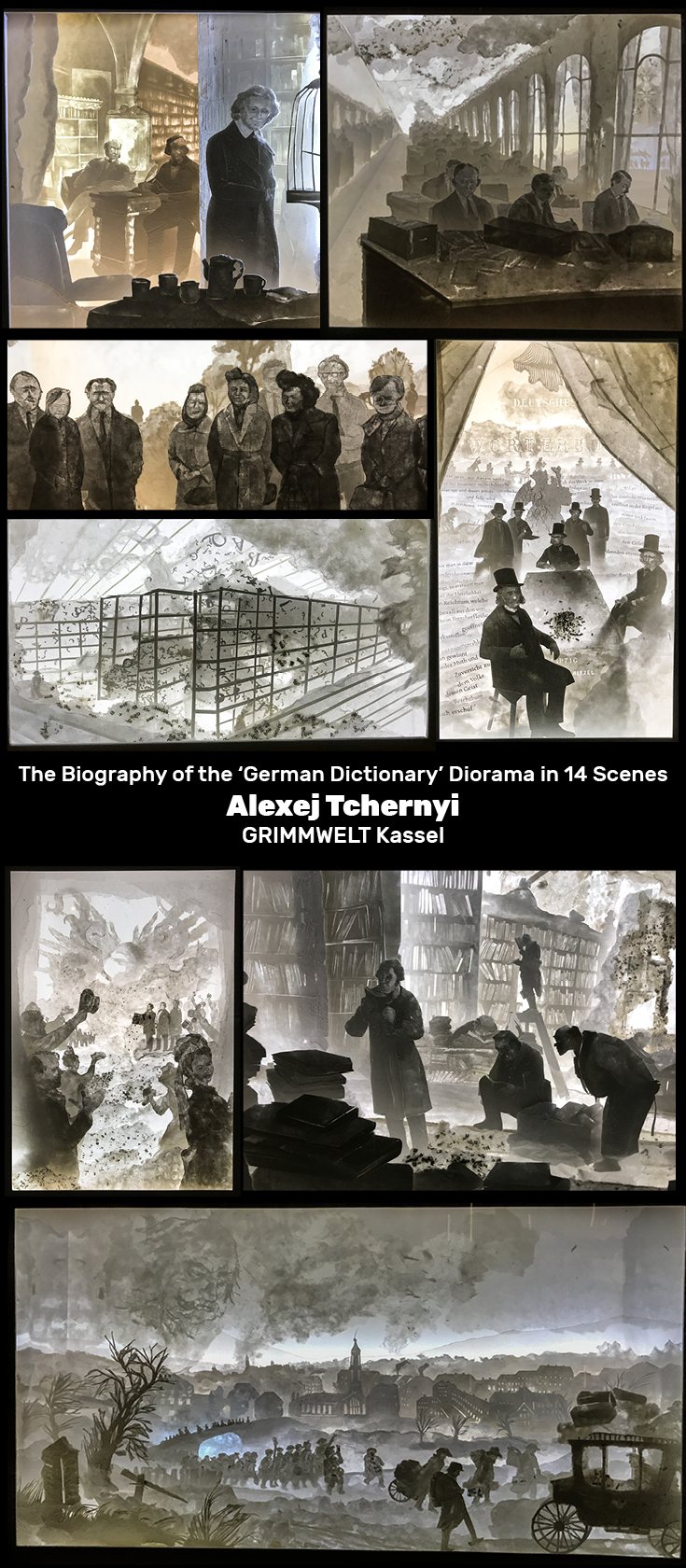
The dioramas are hosted in a very dark exhibit hall and are theatrically lit from within. Each of the scenes has descriptions below in English and German. At the end of this floor is a massive wall of copies of Grimm’s fairy tales translated across sixty-three different languages, transitioning into the lower floor marked by tree roots that delves deeper into Grimms’ fairy tales.
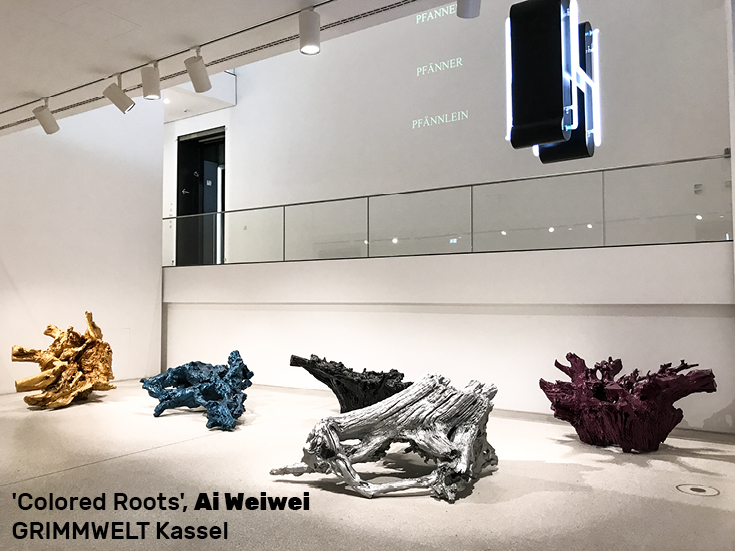
Colored Roots Sculpture by Ai Weiwei
GRIMM WORLD benefits from contemporary artwork in exploring the theme of 'Roots' in the brothers’ work. In the mezzanine level, five different tree roots have been painted solid metallic colors. But why? At first I wonder if it's related to the idea of fairy tale forests, but I learn Ai Weiwei, a Chinese artist with deep attachments for the city of Kassel, meant for the sculpture to be two-fold, not only fairy-tale forests, but also representing the brothers’ intense study and fascination of the ‘roots’ of words and how the Germanic language has grown and changed over time. The tree roots that he used for the sculpture were brought over from China!
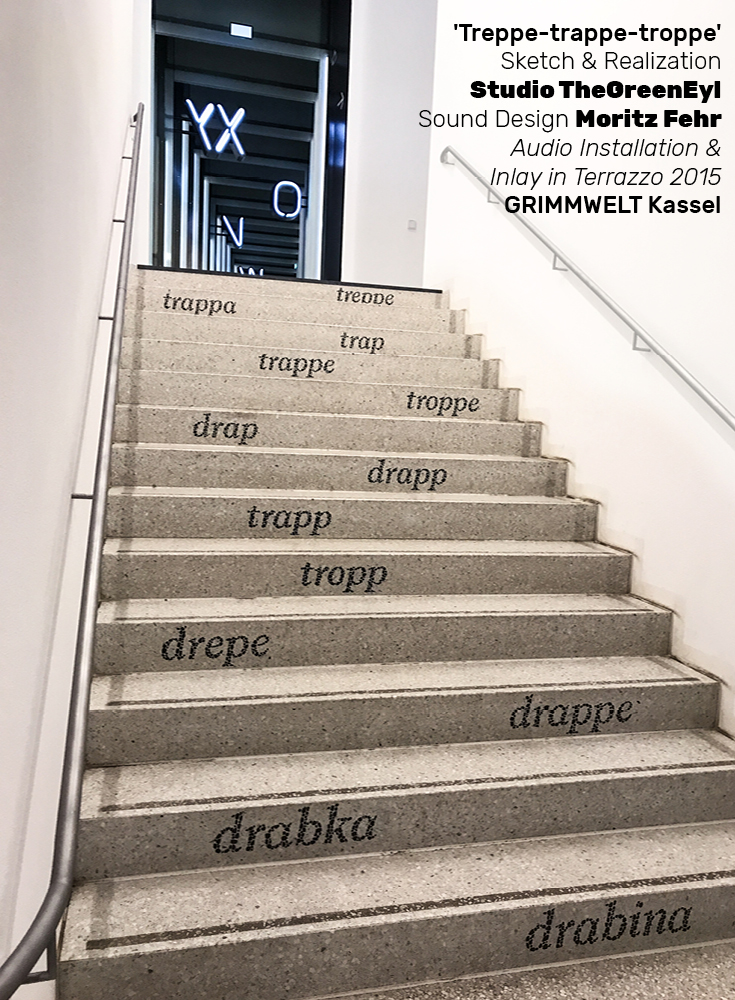
Treppe Troppe Drappe Installation by Studio TheGreenEyl
As you descend stunning terrazzo steps to the rest of the exhibits, motion sensing audio is triggered, surprising the intrepid museum explorer into wondering if the stairs are enchanted? Sort of! Art comes to the rescue again to explain the Grimm brothers’ interest in how something sounds affects the development of the word itself. To illuminate, as you make ‘trip-trap’ sounds down the treppe, the German word for stairs, you’ll hear voices say versions of the word treppe across time. Very clever!
Now Entering The World of Fairy Tales
The bottom floor is surreal, clever, and surprising. I didn’t know where to look first! To the left you see a larger than life sculpture ‘Maerchenbombe’ or Fairy Tale Bomb by the artists Lutz and Guggisberg, rightly titled as it looks like a big egg has hatched and little creatures are escaping towards the visitor.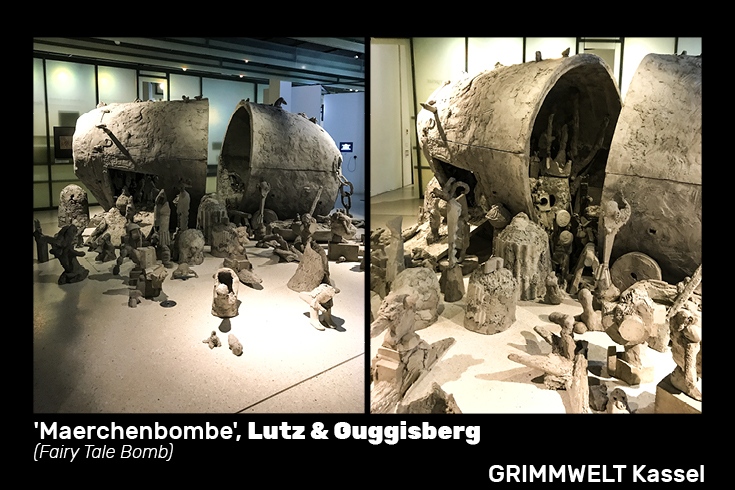
To the right is ‘Hedge of Thorns,’ or columns of artificial turf that natural curiosity beckons you to explore. Hopping along on the floor, are projected images of frogs, or frog princes? ‘Hedge of Thorns is one part of a six-part series of installations called ‘The World of Fairy Tales.’ We had a great time trying out each part and seeing what the artists had in store for us. My favorite being ‘At The Table with the Seven Dwarfs.’ I sat down as directed, and my image was projected into a scene where the dwarves interacted with me as though I was a surprise guest.
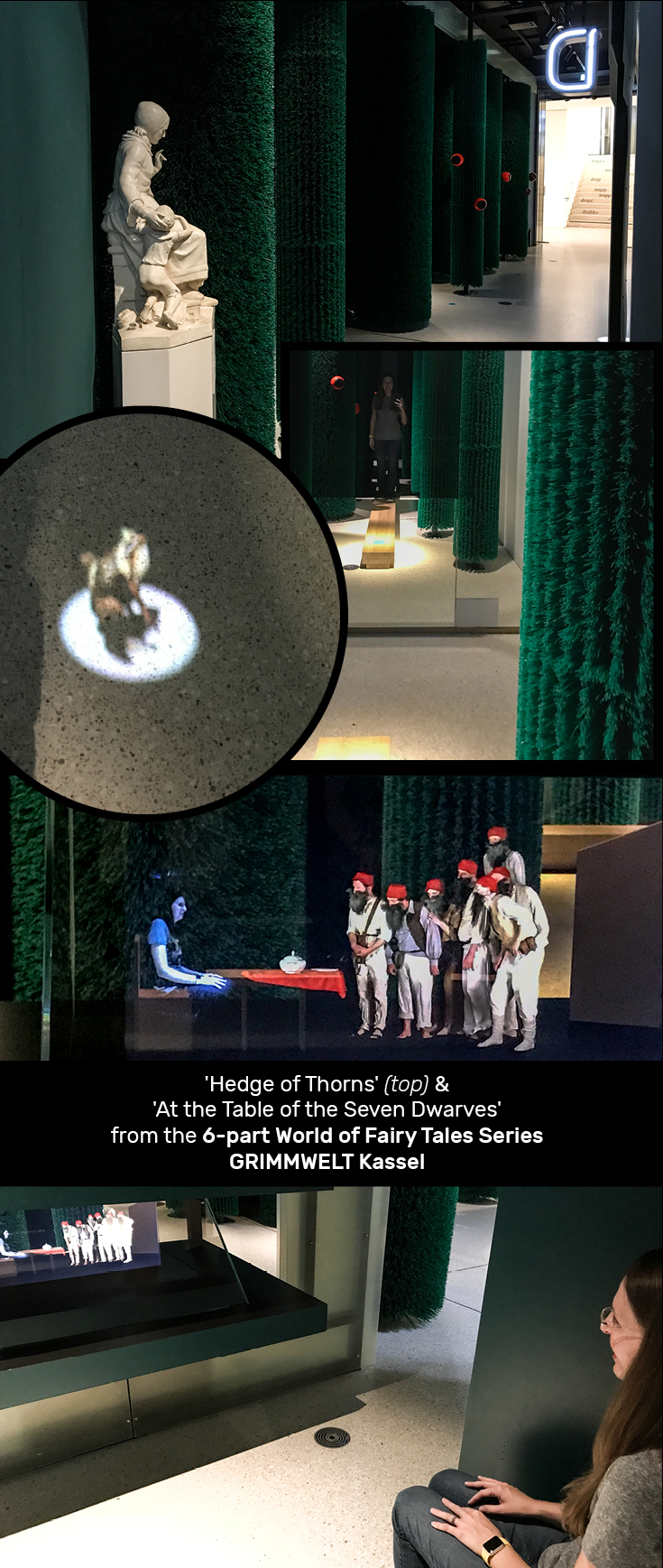
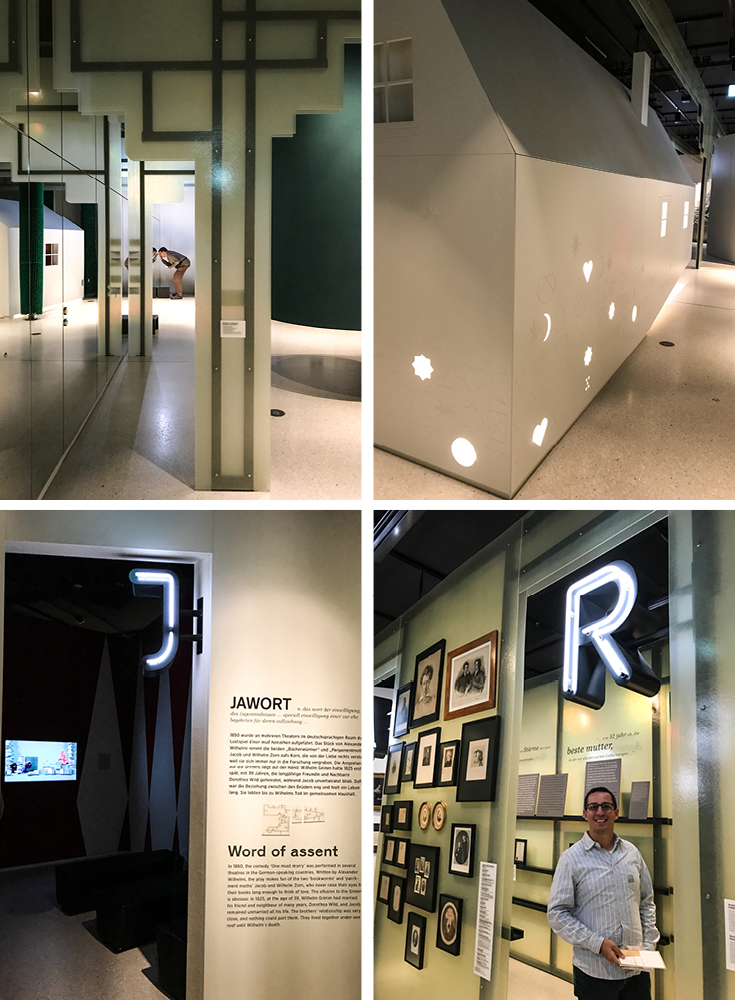
The Other Brother Grimm: Artist Ludwig Emil Grimm
After, the exhibits circle back to what the daily life of the Grimm family was like through original furniture on display, examples of the foods they ate and how their sister improvised with leftovers, and personal narratives and sketches from another Grimm brother, Ludwig Emil Grimm. I always assumed that there were only two brothers Grimm, Jacob and Wilhelm, but that’s not true. The two brothers were of six siblings who survived infancy. It is often said that Ludwig Emil’s illustrations greatly helped make the original Grimm’s fairy tales a success.
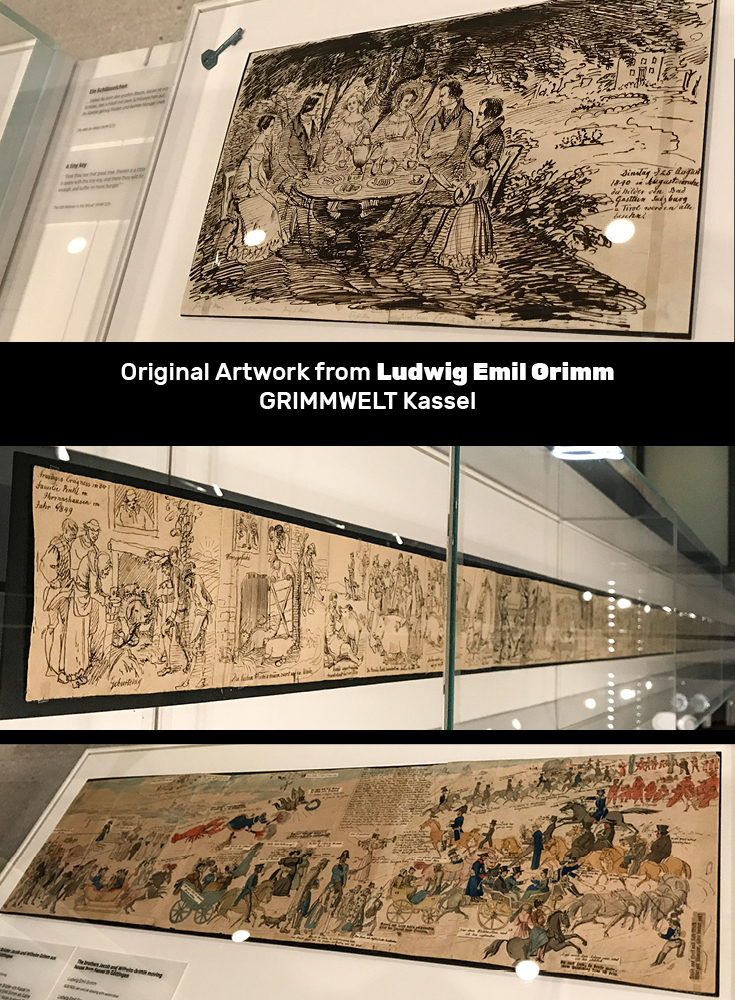
I fell in love with Ludwig Emil’s work upon sight. GRIMM WORLD Kassel has several original sketches and illustrations. My favorite was ‘A brief biography of a remarkable and tender sow / born 1849 in Ihringshausen’. Using 30 sheets of paper, he constructed a 25-foot long scroll that tells the life story of a pig that the Grimm family bought from the pig’s birth until it was eaten! I wish there was an English translated version! Its pictured above in the middle of the three pieces.
Café/Restaurant FALADA & Gift Shop
When we were done we had a really good lunch at the on-site restaurant Falada. Sebastian’s Dad had a cappuccino and a slice of cake, Sebastian and I had cheeseburgers and split some fries. It was really good, and has a nice panoramic view over Kassel. The gift shop was small, and not much in English. I was surprised, with subject matter like the Grimm Brothers I was expecting a lavish fairy tale gift shop, but it was lean selection attached to the ticket counter, and only high-brow gifts, posters, and monographs.
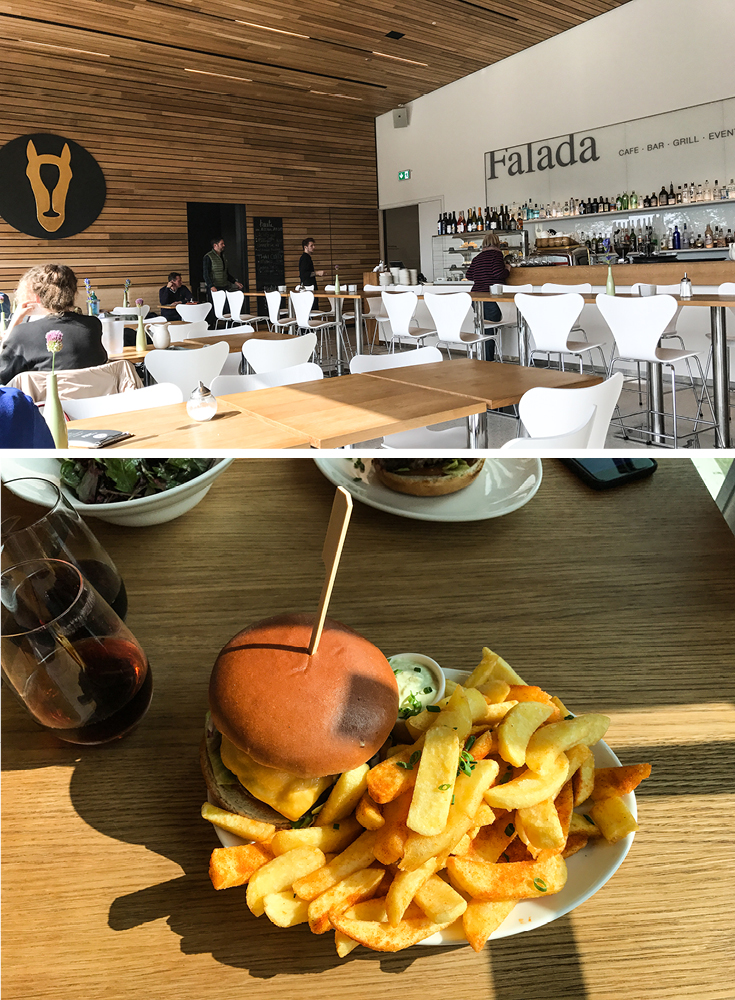
Time Spent at GRIMM WORLD
We spent probably two hours in the exhibits, but could easily see a visit being 2.5-3-hours if you read every single thing and watched all of the movies and documentaries they had playing in the bottom floor. For the most part we all went through the museum on our own, but met up from time to time. There was an immense amount of content to read, so it was difficult for everyone in the group to read the same speed. Everything, or 90% was delightfully in English! For more information, visit their official English language website Grimm World here.
Follow Along
If you enjoyed this article, or these topics sound interesting to you, you'll love our weekly newsletter. You'll receive the newest posts each week and exclusive access to free planning resources like ‘Packing List & Tips for 2 Weeks in Germany’ and ‘Everything You Need to Rent a Car in Germany’.
Thank you for reading!

Centrally located in the middle of the pedestrian zone, the Kurpfälzisches Museum der Stadt Heidelberg, Electoral Palatinate Museum, is located inside the Palais Morass, a Baroque palace building. The history of the museum dates back to the initiative of the French emigre, Count Charles de Graimberg, who from 1810 began to devote himself to preserve the history of the Heidelberg Palace and the Palatine Princely House. His collection of coins, pictures and altars as well as sculptures (over 3,500) are the foundation of the Kurpfalz Museum.
The art collection of Charles de Graimberg was purchased from the city in 1879 and the museum was opened in 1908. After adding a new building in 1991 adjacent to the palace building, the collection grew immensely, and makes the museum experience itself a wild adventure of different styles of rooms, floors, and exhibits. It feels like the inside is so much bigger than the outside lets on. Besides collections of paintings from the 15th to the 20th century, you can also find sculptures, porcelain, Heidelberg city history, and costumes from a bygone era. Denise fell in love with Karl Weysser’s painting ‘Alte Poststation in Heidelberg mit Blick in die Seminarstrasse,’ and finding a postcard with the artwork on it in the gift shop made her very happy.
Besides art, there are also numerous archaeological finds in the museum, mainly through the remains of the Roman Neckar Bridge, which was discovered in 1877. Further archaeological excavations in Heidelberg and the surrounding palatine area after WWII, made the collection grow considerably.
History, art, porcelains, historical costumes, archaeology, period interiors, the Kurpfälzisches Museum der Stadt Heidelberg has something for everyone, and we enjoyed it very much! For more information regarding visiting hours and the history of the museum, visit their official site Kurpfälzisches Museum.
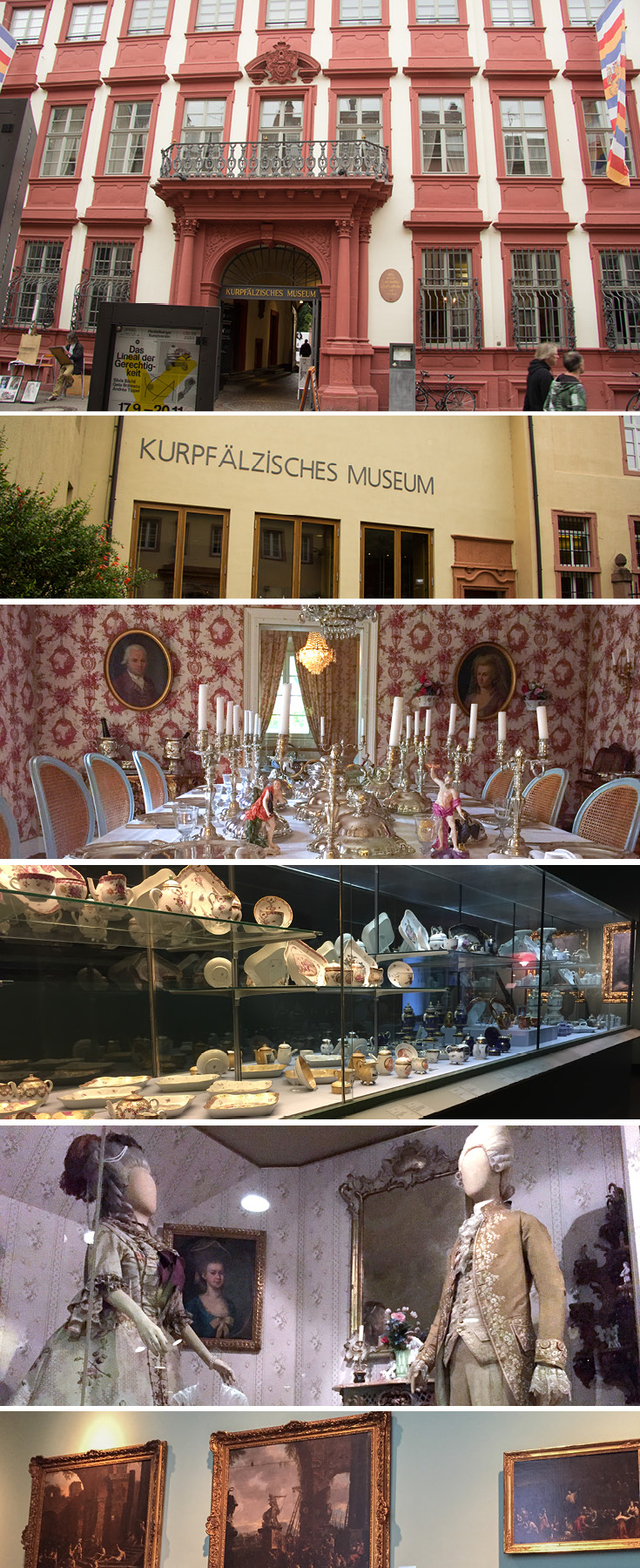
Follow Along
If you enjoyed this article, or these topics sound interesting to you, you'll love our weekly newsletter. You'll receive the newest posts each week and exclusive access to free planning resources like ‘Packing List & Tips for 2 Weeks in Germany’ and ‘Everything You Need to Rent a Car in Germany’.
Thank you for reading!

